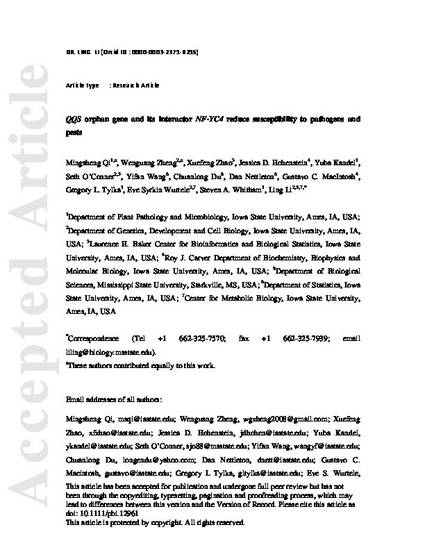
Enhancing the nutritional quality and disease resistance of crops without sacrificing productivity is a key issue for developing varieties that are valuable to farmers and for simultaneously improving food security and sustainability. Expression of the Arabidopsis thaliana species‐specific AtQQS (Qua‐Quine Starch) orphan gene or its interactor, NF‐YC4 (Nuclear Factor Y, subunit C4), has been shown to increase levels of leaf/seed protein without affecting the growth and yield of agronomic species. Here, we demonstrate that overexpression of AtQQS and NF‐YC4 in Arabidopsis and soybean enhances resistance/reduces susceptibility to viruses, bacteria, fungi, aphids and soybean cyst nematodes. A series of Arabidopsis mutants in starch metabolism were used to explore the relationships between QQS expression, carbon and nitrogen partitioning, and defense. The enhanced basal defenses mediated by QQS were independent of changes in protein/carbohydrate composition of the plants. We demonstrate that either AtQQS or NF‐YC4 overexpression in Arabidopsis and in soybean reduces susceptibility of these plants to pathogens/pests. Transgenic soybean lines overexpressing NF‐YC4 produce seeds with increased protein while maintaining healthy growth. Pull‐down studies reveal that QQS interacts with human NF‐YC, as well as with Arabidopsis NF‐YC4, and indicate two QQS binding sites near the NF‐YC‐histone‐binding domain. A new model for QQS interaction with NF‐YC is speculated. Our findings illustrate the potential of QQS and NF‐YC4 to increase protein and improve defensive traits in crops, overcoming the normal growth‐defense trade‐offs.
Available at: http://works.bepress.com/gregory-tylka/264/

This article is published as Qi, Mingsheng, Wenguang Zheng, Xuefeng Zhao, Jessica D. Hohenstein, Yuba Kandel, Seth O'Conner, Yifan Wang, Chuanlong Du, Dan Nettleton, Gustavo C. MacIntosh, Gregory L. Tylka, Eve Syrkin Wurtele, Steven A. Whitham, and Ling Li. "QQS orphan gene and its interactor NF‐YC 4 reduce susceptibility to pathogens and pests." Plant Biotechnology Journal 17 (2019): 252-263. DOI: 10.1111/pbi.12961.